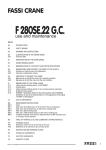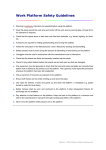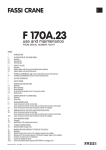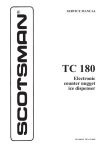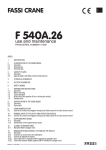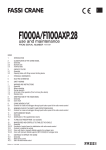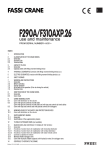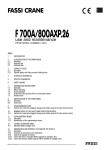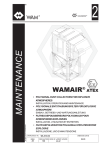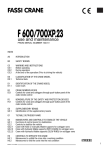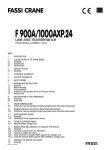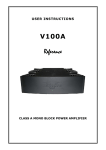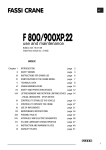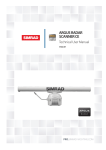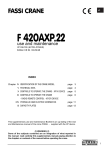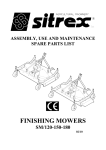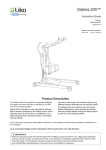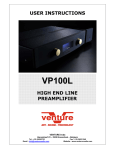Download Fassi F330Se.24 - Fallsway Equipment Company
Transcript
FASSI CRANE cI F 330SE.24 G.C. use and maintenance FROM SERIAL NUMBER *5151* INDEX Chapter Edition 24.04.2008 I INTRODUCTION page 2 II SAFETY NORMS page 3 III INSTRUCTIONS FOR CRANE USE page 7 IV IDENTIFICATION OF THE CRANE MODEL page 8 V TECHNICAL DATA page 9 VI CRANE NOMENCLATURE page 12 VII SAFETY AND PROTECTION DEVICES page 14 VIII LIFTING MOMENT LIMITING DEVICE page 16 IX CONTROLS TO STABILIZE THE VEHICLE page 18 X CONTROLS TO OPERATE THE CRANE page 21 XI USE OF IMPLEMENTS page 24 XII MAINTENANCE INSTRUCTIONS page 25 XIII POSSIBLE FAULTS page 30 XIV HYDRAULIC AND ELECTRIC SCHEMATICS page 31 XV OIL AND LUBRICANT CHARACTERISTICS page 33 A INSTRUCTION AND WARNING PLATES page 34 B CAPACITY PLATES page 37 1 cI INTRODUCTION F 330SE.24 FASSI CRANE F 330SE.24 G.C. use and maintenance This instruction manual describes the FASSI CRANE F330SE.24 G.C. The fitment must be carried out in accordance with the instructions given by the Manufacturer in the manual for hydraulic crane fitting. The Manufacturer declines all responsibility and guarantee if the fitting is entrusted to workshops without sufficient technical capability to carry out the work in conformity. As well as the principal safety norms, this manual contains a description of the crane and the instructions for use and maintenance. The crane must only be operated by responsible persons, previously instructed and authorized. THANK YOU FOR SELECTING ONE OF OUR CRANES. 2 SAFETY NORMS (!) SAFETY NORMS F 330SE c II This symbol draws your attention on the points concerning safety. It means: WARNING! BE CAREFUL! IT CONCERNS YOUR SAFETY! !ATTENTION! READ THIS MANUAL CAREFULLY prior to use of the crane or any maintenance. A few minutes spent now could save time and labour later. Be sure that the unit has been installed, inspected and tested in accordance with the local legal requirements. To operate the crane it is necessary to fully understand its working, safety and warranty norms. Check that protections are in their place and that all safety devices are fitted and active. Warning plates, as well as instruction and operation plates must be replaced when no longer readable or missing. (See chapters A - B) Do not run the engine in a indoor area without first making sure there is adequate ventilation. Fit a suitable extension tube to the vehicle exhaust pipe to take the fumes away from the working area. Stabilize the vehicle checking that they rest on a solid base; if necessary use larger outrigger base plates (available on request) to avoid sinking. If you adopt other means, make sure that they are suitably sized for the load they must bear. Stabilize the vehicle on a horizontal plane with a maximum tolerance of 1,5 degrees. Never operate the outriggers when the crane is loaded. Remember that the stability of the unit (crane-vehicle) is only guaranteed by the fully lateral extension of the outriggers. Should visibility be insufficient, make sure that control stations are properly lighted so as to ensure safety while operating control functions and allow reading of the plates. Before manoeuvering a load check that the working area is adequate and properly lighted for your crane. Make sure that the hook is always free to rotate on its pin and that nothing obstructs its vertical positioning. Check the efficiency of the hook safety catch. 3 c II SAFETY NORMS F 330SE Carefully inspect the load rigging and the condition of ropes or chains. Make sure that the lifted load is balanced. Hook up the load, checking that it does not exceed the capacity indicated on the lifting diagram specific to each load configuration. It is absolutely prohibited to walk or stop under a suspended load and for unauthorized persons to be within the working area. Avoid swinging the load above the control station; any hidden danger situation must be audibly alarmed. Avoid all those situations which may result in crushing during crane stabilization, movement and load handling. The table reports the minimum safe working distances to avoid crushing parts of the body. Parts of the Body Minimum safe working distance mm Figure Parts of the Body Minimum safe working distance mm Body 500 Head 300 Leg 180 Foot 120 Toes 50 Arm 120 Hand Wrist Fist 100 Finger 25 Figure In conformity with “EN 349” Standard the minimum safe working distances to avoid crushing parts of the body. 4 NOTE: Failure to respect the minimum safe distances may result in a deadly risk for the operator and his assistants. Maintain safe clearances from electrical lines and apparatus. You must allow for boom sway, rock or sag and electrical line and loadline swaying. This lifting device does not provide protection from contact with or proximity to an electrically charged conductor. You must maintain a clearance of at least 10 feet between any part of the crane, loadline or load and any electrical line or apparatus carrying up to 50.000 volts. One foot additional clearance is required for every additional 30.000 volts or less. SAFETY NORMS F 330SE c II NOTE: Failure to respect the minimum safe distances may result in electrical hazards for the operator and his assistants. Do not utilize the crane with stormy weather or with wind speed exceeding 12,5 m\s (value 6 of the Beaufort scale). Indications about wind speed Force of the wind Beaufort scale Wind speed Classification m/s Characteristics 0 0,0 - 0,2 Calm Calm wind, smoke goes up quite vertically 1 2 0,3 - 1,5 1,6 - 3,3 Light breeze Smoke reveals the direction of the wind, one can feel the wind blowing, leaves start fluttering. 3 4 3,4 - 5,4 5,5 - 7,9 Moderate breeze Leaves and branches are in constant motion, small branches start fluttering. Dust and papers dance on the ground. 5 8,0 - 10,7 Fresh breeze Small green branches bend, the surface of waterways and lakes are wavy. 6 10,8 - 13,8 Near gale Big branches bend, wind whistles through high-tension cables, it's difficult to walk keeping the umbrella open. 7 13,9 - 17,1 Moderate gale Trees sway, it's hard to walk. 8 17,2 - 20,7 Storm wind Branches get broken, it's hard to walk. 9 20,8 - 24,4 Storm It damages houses (antennas and roof tiles fall down) 5 c II SAFETY NORMS F 330SE For cranes with top seat controls, it is necessary to use a ladder and a cat walk to reach the control station. When operating from the top seat, stay within its side safety guards. Do not rotate the crane before the load is lifted, do not operate with sudden movements, activate the controls with slow and progressive movements. Rotate slowly and with care paying attention to the stability of the vehicle. With vertical lift, on hydraulic and mechanical extension, rotate slowly in order to avoid side-skidding. Do not utilize the crane for pushpull, lateral or sideways operations. Do not move the vehicle if a load is suspended on the crane. Under no circumstances interfere with the safety and protection devices. The vehicle\crane must not be left unless the load is on the ground, the booms of the crane are folded and laid on a solid base and the power take-off is disengaged. At the end of the job and prior to driving the vehicle the crane must be folded. If the booms are to be laid on the body or on the load, they must be blocked to prevent possible sideways movements. NOTE Implements can be left mounted on the booms of the crane only if the overall dimensions are respected. THE FORK MUST BE TIED DOWN AT ALL TIMES DURING TRANSPORT Make sure that the outrigger rams are lifted and the supports reentered within the overall width of the truck. Disengage the power take off. To avoid hitting bridges or tunnels check and record the overall height of your crane in the folded position or in laid position in the body or on the load. Always respect and pay proper attention to road signs placed in proximity of such obstacles. 6 INSTRUCTIONS FOR CRANE USE INSTRUCTIONS FOR CRANE USE F 330SE The use of the crane is reserved to authorized personnel, instructed in advance, who has to strictly conform to the safety norms and instructions contained in the instruction manual supplied with the crane. c III 1 — Only authorized persons are allowed to operate the crane. 2 — The crane must be used on firm, level ground. 3 — Check that the vehicle hand brake is on and that the wheels are chocked. 4 — Before every operation make sure that: — no-one is within the working area of the crane; — the safety devices are in place and operative; — the minimum safe working distances from power lines are observed; — the load is correctly slung and hooked. 5 — Stabilize the vehicle by the outrigger rams, making sure that: — the lateral supports are fully extended; — the wheels are in contact with the ground and the suspension is not completely unloaded; 6 — Use the crane in accordance with the use and maintenance manual, making sure that: — the load and radius are within the maximum limits shown on the crane capacity plate; — the crane is used progressively avoiding sudden load movements; — swinging or dragging of the load is avoided; — the load is lifted before rotating. 7 — When using implements protect the crane working area with a barrier. 8 — The vehicle/crane are not left unless the power take off is disengaged and the load is on the ground. 9 — Before driving the vehicle make sure that the outriggers are fully retracted and re-entered, and the crane is in folded position. fig. 1 THESE INSTRUCTIONS FOR THE USE OF THE CRANE COINCIDE WITH THOSE OF THE PLATE DE2676 (FIG. 1) PLACED NEXT TO THE CRANE. 7 c IV IDENTIFICATION OF THE CRANE MODEL IDENTIFICATION OF THE CRANE MODEL F 330SE The exact crane model, serial number and description of implements will enable FASSI Service Department to give a rapid and efficient response. Identification data of the crane are marked on the plate DE2141 and fixed on the base. 1 1 — Crane model 2 — Serial Number 3 — Year of manufacturing 2 3 (!) 8 UNDER NO CIRCUMSTANCES SHOULD THE DATA MARKED ON THE PLATE BE ALTERED. TECHNICAL DATA TECHNICAL DATA F 330SE.24 cV The design of this crane has been carried out in respect of DIN 15018 norms, fatigue test classification H1B3 . (!) The crane can operate, intermittently, with lifting devices other than the hook. The dimensions and the capacity of the implements must be proportioned with crane performances. F 330SE.24 Lifting capacity Standard reach Hydraulic extension Rotation arc Rotation torque Working pressure 18,6 tm 182,5 kNm 17,9 m 9,54 m 400° 4,69 tm 25,0 MPa 134605 lbf.ft 58’9” 31’4” 400° 33927 lbf.ft 3625 psi Pump capacity Oil tank capacity 60+60 l/min 180 l 46 kNm 16+16 PESO GRU CON SERBATOIO NON RIFORNITO, STABILIZZATORI STANDARD WEIGHT OF THE CRANE WITH EMPTY TANK, STANDARD STABILIZATION POIDS DE LA GRUE AVEC RESERVOIR VIDE, STABILISATION STANDARD KRANGEWICHT MIT LEEREM TANK UND STANDARDABSTUETZUNG 48 gals Crane weight Max. working pressure on the outrigger () 500) () 1’7”) 4800 kg 10582 lbs gal/min kg 120 psi 8,3 daN/cm2 4.800 lbs 10.582 F 330SE.24 ST 331 9 cV TECHNICAL DATA F 330SE F 330SE ST 331 10 TECHNICAL DATA F 330SE F 330SE cV MASSIMA ALTEZZA SOTTOGANCIO. HAUTEUR MAXIMUM SOUS CROCHET. MAXIMUM HOOKING POSITION. MAXIMALHOEHE BIS KRANHAKEN ST 331 11 c VI CRANE NOMENCLATURE CRANE NOMENCLATURE (fig. 2) F 330SE Pos. 1 2 3 4 5 6 7 8 9 10 11 12 13 14 15 16 17 18 19 12 Description - Outrigger rams Outrigger supports Base Rotation cylinders Column Inner ram Inner boom Outer ram Outer boom Booms extension rams Extension boom sections Deviator crane - outriggers Distributor for outriggers Dual control for deviator crane - outriggers Outrigger multifunctions transmission Supplementary hoses (hydraulic implements) Oil tank Distributors for crane Double control for crane distributors CRANE NOMENCLATURE F 330SE c VI fig. 2 13 c VII SAFETY AND PROTECTION DEVICES SAFETY AND PROTECTION DEVICES (fig. 3) F 330SE Pos. 1 2 3 4 5 6 7 8 9 10 11 12 13 14 15 Description - Check valves for outrigger rams Check valve for rotation control Check valve for inner ram Check valve for outer ram Check valve for booms extension rams Lifting moment limiting device assembly Parachute valves (lifting moment limiting device) Main pressure valve (outrigger distributor) Main pressure and auxiliary valves (crane distributors) Carter for outer ram Carter for hose protection devices Carter for booms extensions ram check valve Levers guard Emergency tap (lifting moment limiting device) Heat exchanger (!) Before crane use check that safety and protection devices are fitted and active. (!) Under no circumstances interfere with the safety and protection devices. (!) Interference with the check valves and removal of the lead seals remove the Manufacturer and invalidate the warranty. 14 SAFETY AND PROTECTION DEVICES F 330SE c VII fig. 3 15 c VIII LIFTING MOMENT LIMITING DEVICE F 330SE LIFTING MOMENT LIMITING DEVICE A characteristic which permits the classification of cranes is their lifting capacity or maximum lifting moment. The moment is defined by the value obtained from the product of the load to be lifted (in lbs) by its distance (in ft) from the centerline of the crane rotation. The device called “lifting moment limiting device” preserves the crane structure from overloads, as it prevents any movement which increases the value of the moment up to the maximum established value. Lifting moment limiting device “INTELLIGENT TYPE” This device utilises an electrohydraulic technology, preventing any movement which causes an increase in the pressure induced by the load in the inner and outer rams of the crane, up to the “critical values”. These values, which are non-exceedable, determine the intervention levels and provide the data for setting the device. fig. 4 fig. 5 The lifting moment limiting device concernes the following manoeuvres: - Inner boom descent; the inner boom lift is controlled by the general main pressure valve of the distributor. - Outer boom lift. - Outer boom descent. - Extension of extension boom sections. The system uses the specific functions of the distributor by utilising an electro-hydraulic technology, it does not allow you exceed the set value, by disactivating the controls (levers in neutral position) commanded by the limiting device. The condition of intervention is operated by the position of the outer boom (or, if hydraulic extension is fitted, the position of the extension outer boom), on which the electronic signal position (mercury level switch) is read by a special electrovalve. This determines controls which are locking or unlocking (resetting) of the controls concerned. When the moment is reduced, it resets automatically (the manoeuvres blocked by the device are released). N.B.: There is a delay of four (4) seconds after the moment reduction before the reset can occur in order to safeguard the stability of the device. The crane configurations (fig. 4-5) indicate the manoeuvres which are allowed and not allowed by the device, in connection with the horizontal position of the crane and extension outer booms. When the moment is reduced, it resets automatically (the manoeuvres blocked by the device are released). (!) CAUTION DANGER (!) On the outer boom there is a mercury capsule (mercury level switch) duly protected and provided with the following warning stickers. MERCURY IS EXTREMELY TOXIC. IN CASE OF REPLACEMENT AND/OR SCRAPPING, DISPOSE OF OR RECYCLE THE CAPSULE CONTAINING MERCURY WITH MAXIMUM CARE, AND IN ACCORDANCE WITH THE NATIONAL REGULATIONS IN FORCE. (!) 16 In the absence of electric power all crane functions will be desactivated. EMERGENCY tap lever fig. 6 LIFTING MOMENT LIMITING DEVICE Each device is fitted with an emergency tap lever to be used in the event of a black-out, electrical or hydraulic malfunctions or whenever the lifting moment limiting device makes it impossible to use any controls when handling a load (this may occur when the extension booms are fully folded and the load is particularly heavy and bulky). Only In these situations it is permitted to remove the lead seal placed on the tap lever and place it in the closed position. (!) ATTENTION (!) Activation of the exclusion device or of the emergency tap lever. When the operator uses this device, it means that he wishes to override the lifting moment limiting device in order to make some manoeuvres (which would be impossible with the device active) that bring the moment to within the level, but involve an overload condition. In such an emergency condition (where the lifting moment limiting device has been disabled), the operator must be: - carefully consider the manoeuvres required to return to normal working conditions; - calmly and carefully assess the type and scale of the hazards arising from these manoeuvres and the possible reaction of the crane (tipping over, frame overload, uncontrolled fall of the load due to a hydraulic system overload etc...); - make all movements as slowly as possible to reduce the dynamic overload to the minimum. F 330SE c VIII fig. 6 After such emergency operations and prior to re-use of the crane, you must immediately go to FASSI authorised Center for testing the structure and resealing of the device. (!) Interferences with the valves or removal of the lead seal release the FASSI GRU IDRAULICHE from any responsibility and invalidate the warranty. (!) ATTENTION (!) The presence of the lifting moment limiting device does not release the user from the obligation to respect what is indicated on capacity plates and lifting curves. (!) ATTENTION (!) Do not walk on the electric control panels. (Plate DE1679) Do not use water to estinguish fire! (Plate DE1680) DE1679 DE1680 17 c IX CONTROLS TO STABILIZE THE VEHICLE F 330SE CONTROLS TO STABILIZE THE VEHICLE The outriggers rams prevent harmful stresses both to the frame and to the vehicle suspensions on which the crane is mounted and assure the stability of the unit during load handling. Be very careful during vehicle stabilization operation; make sure that no one is or transits in close proximity of the working area of the outriggers specially in the case that the outrigger controls is executed from the opposite side of the vehicle (it is not possible visually check the operation). (!) ATTENTION (!) The crane stability is maintained by the maximum extension of the outrigger supports, by the solidity of the base underneath the plates of the outrigger rams and by the observance of the capacity plates. To check the maximum working pressure see Paragraph D0.1 Technical data. Check that the outrigger rams are applied on a solid base; if necessary use larger outrigger base plates (available on request) to avoid sinking. When stabilization is complete the wheels of the vehicle must still be in contact with the ground and the suspensions must not be fully unloaded. Stabilize the crane so as to operate on a horizontal plane with a maximum tolerance of 1,5 degrees. While loading, it may be necessary to vertically adjust the outrigger rams to prevent an overload on the outriggers, then stabilize again. While unloading, the outrigger rams may not be perfectly in contact with the ground because of a rise in the suspension; it is therefore recommended to stabilize the vehicle during operation to avoid an overturn. Functions of control levers for stabilization The controls to stabilize the vehicle are activated only from ground level and on both sides of the crane base. NOTE The graphic symbols illustrated hereunder are marked on the plates (DE4486DE4487-DE4485-DE4497-DE4488-DE4489) affixed next to the control stations and indicate with the following symbolism. They indicate the position of the operator in relation to the vehicle and the crane. Lever CD for selecting outrigger ram or outrigger support Levers D Deviator Lever C to control outrigger support or outrigger ram See Paragraph R0 Instruction and warning plates. Lever function D - CD - C Levers D Control for deviator crane-outriggers ( - E\S ). Levers CD Control for selecting the supports or the outrigger rams. Levers C Control for the support or the outrigger ram selected 18 -E/S CONTROLS TO STABILIZE THE VEHICLE The "multifunction" control group adopted allows to select and manoeuvre the outrigger support or the ram, through simultaneous operation of the selecting lever CD and the control lever C. CD Exemple To select the support E2 or the outrigger ram S2 - Position the lever CD (corresponding to outrigger support E2 and to outrigger ram S2) on E2 or S2 and keep it in position. To carry out the operation - Operate lever C to activate the exit/re-entry of outrigger support E2 or the descent/lift of outrigger ram S2. c IX F 330SE D C Special base plates (detachable) The outrigger rams of the crane and of the supplementary outriggers they are supplied with base plates which can be fastened to the ram stems through jaw securing devices. Fastening of the base plate - Place the base plate underneath the ram, remove the check pin and open the anchor jaws. (fig.10-10a) - Operate the corresponding lever S to control the descent of the ram until the ball joint touches the seat cut in the base plate; close the jaws and secure them in their seat with the check pin. (fig. 10b-10c) fig. 10 fig. 10a fig. 10b fig. 10c Removal of the base plate - Release the check pin and open the anchor jaws. - Operate the corresponding lever S to control the re-entry of the ram. - Close the jaws, secure them with the check pin and remove the base plate. (!) For the safety and for the encumbrances we recommend to remove the plates before putting the rams to the rest position; special handles are featured for the plates handling and the opening and closing of the securing device (jaws). (!) WARNING (!) Keep clean the ball joint heads of the outrigger rams and the seats cut in the base plates to avoid their deterioration. fig. 12 Controls to stabilize the vehicle fig. 13 Controls for positioning the outriggers of the crane and the supplementary beam. (!) WARNING (!) Due to the special construction of the hydraulic circuit (double circuit with two pumps) the distributor placed on the right of the operator (rotator control, outer ram and crane rotation) is alimented by one pump also with the lever D of oil-diverter crane-outriggers ( - E/S) on E/S. The controls are activated on both sides, on crane distributors side (DE4485 fig. 12) or on crane double controls side (DE4497 fig. 13) (!) ATTENTION (!) When controlling the outriggers from the opposite side of the vehicle (it is not possible visually check the operation) make sure that no one is or transits in close proximity of the working area of the outriggers. (Fig. 11 plate DE2497 and fig. 12 plate DE2498) fig. 11 fig. 12 19 c IX CONTROLS TO STABILIZE THE VEHICLE F 330SE (!) ATTENTION (!) Operation of the crane outrigger supports must be from the control station on that side; it is not allowed to operate outriggers on the opposite side of the vehicle due to unseen dangers. DE4491 See Paragraph "Special base plates" for details of the fastening of the base plates on the outrigger rams. Position lever D of oil diverter ( -E/S) on E/S. DE4488 How to exit the outrigger support E2 (crane) - Operate the corresponding lever CD towards right (E2) and keep it in position. - Operate the lever C towards right to exit the outrigger support. How to descent the outrigger ram S2 (crane) - Operate the corresponding lever CD towards left (S2) and keep it in position. - Operate the lever C towards right to descent the outrigger ram. How to exit the outrigger support E3 (supplementary outriggers) - Operate the corresponding lever CD towards right (E3) and keep it in position. - Operate the lever C towards right to exit the outrigger support. How to descent the outrigger ram S3 (supplementary outriggers) - Operate the corresponding lever CD towards left (S3) and keep it in position. - Operate the lever C to descent the outrigger ram. How to exit the outrigger support E1 (crane) - Operate the corresponding lever CD towards right (E1) and keep it in position. - Operate the lever C towards right to exit the outrigger support. How to descent the outrigger ram S1 (crane) - Operate the corresponding lever CD towards left (S1) and keep it in position. - Operate the lever C towards right to lift the outrigger ram. How to exit the outrigger support E4 (supplementary outriggers) - Operate the corresponding lever CD towards right (E4) and keep it in position. - Operate the lever C to exit the outrigger support. How to descent the outrigger ram S4 (supplementary outriggers) - Operate the corresponding lever CD towards left (S4) and keep it in position. - Operate the lever C to descent the outrigger ram. (!) ATTENTION (!) The complete extension of the outrigger supports is visually indicated by the yellow triangles which are found at the end of the beam (and of the support if it’s supplied with extra double extension beams). The stabilization has to be carried out with care and gradually keeping the vehicle in horizontal levelled condition to prevent springs overloads and chassis torsions. (!) ATTENTION (!) During the stabilising operations, for each outrigger ram, it is recommended to DESCENT the outrigger as the last manoeuvre. To operate the crane controls, after having completed the descent and stabilisation manoeuvres, - Position lever D of oil diverter ( - E/S) on . Manoeuvres for re-entry of the crane outriggers and supplementary outriggers within the overall vehicle width after crane use. Position lever D of oil diverter ( - E/S) on E/S. See Paragraph "Special base plates" for details of the removal of the base plates from the outrigger rams. How to lift the outrigger ram S - Operate the corresponding lever CD towards left (S) and keep it in position. - Operate the lever C towards left to lift the outrigger ram. How to re-enter the outrigger support E - Operate the corresponding lever CD towards right (E) and keep it in position. - Operate the lever C towards left to re-enter the support. 20 (!) WARNING (!) Assure that the outrigger supports and rams are completely re-entered before moving the vehicle. CONTROLS TO OPERATE THE CRANE CONTROLS TO OPERATE THE CRANE (!) WARNING (!) Before operating the crane it is compulsory to set the outriggers. cX F 330SE This coincides with that indicated on the plate DE6723 placed on the outriggers. Fig. 13 (!) Operate the levers smoothly and gradually. Hydraulic implements and crane controls The control stations are on base-plate; the crane and the hydraulic implements controls are bilateral, manual and sequential type. The crane adoptes Danfoss distributors manual control with electric modulars for remote controls and emergency electro-valve manual block. (!) WARNING (!) In the absence of electric power all crane functions will be desactivated. Distributor side The left distributor, respect to the operator, control three functions (left to right): Pallet-fork Extension booms fig. 13 Outer boom The right distributor, respect to the operator, control three functions (left to right): Fork rotator Inner boom Crane rotation Double control side The levers control (left to right, respect to the operator) Pallet-fork Extension booms Outer boom Fork rotator Inner Inner Crane rotation The symbols placed over each lever define their function in relation to their movement. (!) First read the instructions given in the User’s Manual supplied by the Manufacturer before using the remote control to avoid improper use. 21 cX CONTROLS TO OPERATE THE CRANE F 330SE Manoeuvres to unfold the crane into a working condition — Engage the power take off. — Stabilize the vehicle as described on Chapter IX. — Before lifting the inner boom, be sure that the outer ram is completely open. — Lift the inner boom over the horizontal line, close the outer boom and eventually extend the booms of the crane. — Operate on the crane rotation to position the pallet-fork on the vertical line above the load, operate on the pallet-fork rotation control (rotator) for the correct orientation of the fork. Manoeuvres to fold the crane into the rest condition — Open the outer boom to its stroke end. — Re-enter the extension boom sections. — Operate the rotation control of the crane and fold the inner boom, paying attention to the crane boom position on the body. It is necesssary during this operation to orientate the pallet-fork position to avoid obstacles on the body or the load. — Lift and re-enter the outriggers as described. — Disengage the power take off. (!) In case of implements on the load or the truck body it is necessary to check they are locked to assure the impossibility of accidental movements. (!) THE FORK MUST BE TIED DOWN AT ALL TIMES DURING TRANSPORT Emergency restoration buttons of the distributors functions with power failure. Fig. 14 (!) WARNING (!) Operating the locking device of the electro-valve connected in every distributors allowes the operator to manoeuvre only and exclusively in case of power failure. The locking device of the electro-valve is instable and allowes to restore the distributor functions operating with two hands; you must keep pressed the device and at the same time operate on the distributor lever in order to effect the stability manoeuvre. fig. 14 22 These buttons must only be used in an emergency and only to bring the crane to its rest position. Load manoeuvres (!) Before manoeuvering the load, verify that the working area is suitable for your crane. CONTROLS TO OPERATE THE CRANE cX F 330SE The lifting curves of the capacity chart indicate the maximum load that the crane can lift at a certain radius and at a certain height. (!) Always remember that when operating with implements, their tare weight must be deducted from the capacity of the crane. During load handling do not exceed the reach limits given, or the load indicated on the above mentioned charts. If the limits are exceeded, the lifting moment limiting device, allowing all manoeuvres, which reduce the lifted load within the permitted reach limits and forbid all other manoeuvres, will be immediately activated. (!) The presence of the lifting moment limiting device does not release the user from the observance of the capacity chart. 23 c XI USE OF IMPLEMENTS F 330SE USE OF IMPLEMENTS OIL COOLER (HEAT EXCHANGER) The crane can be equipped with an oil cooler (air-oil heat exchanger) to prevent damage caused by an excessive increase of the oil temperature. NOTE When working in a low temperature climate, we recommend to bring the hydraulic oil up to working temperature prior to starting work, This is best done by operating the crane thru all its functions ram stroke end. (!) WARNING (!) The heat exchanger openings must be kept clear and clean. At no time should it be covered. HYDRAULIC ACCESSORIES The crane can be provided with implements such as: - Fork rotator - Pallet-fork (!) When using an implement it is always necessary to check that its weight, dimension and capacity is matched to the crane performances. (!) Warning and norms for crane use also apply for hydraulic implement use. (!) Always remember that when operating with implements, their tare weight must be deducted from the capacity of the crane. Hydraulic connections between implements and hoses fitted on the extension boom section of the crane. (!) In case of hoses connection to implements through coupling unions it is necessary to verify that there is no trace of soil, curt etc. on the unions and inside the seats so as to avoid the oil contamination and consequently wear the tightening “ surface of unions. (!) WARNING (!) To ensure that the control corresponds to the implement movement, hydraulic connections are symmetrically fitted with coupling unions. Never invert such positions: movements inversion as well as operating difficulties could occur. 24 MAINTENANCE INSTRUCTIONS MAINTENANCE INSTRUCTIONS To assure a long life to the crane, it is necessary to meticulously follow the instructions. F 330SE c XII General lubrication and small repairs can be carried out by the user; repairs of a more complicated nature must be carried out by authorized service personnel. Spare parts must be original. At least once a year you must take the crane to a Fassi Service Center for a check. Good maintenance and proper use are imperative to maintain efficient use and guarantee the safety of the crane. (!) Before disconnecting any hydraulic hoses, ensure that there is no pressure in the hydraulic circuit. After removing hoses always mark them and their respective ports on the crane. Faulty replacement can cause damage to the rams and to the hydraulic circuit. Respect the information supplied for maintenance and technical assistance. Any maintenance operation must be carried out with the crane power source turned off. (in case of fixed mounting with hydraulic power pack, the electric motor has to be turned off). Do not place limbs, fingers or any other parts of anatomy into areas of the crane, which present possibilities of shearing, without having blocked such parts of the crane. Do not weld, drill or grind any part of the crane without the Manufacturer’s authorisation. Do not weld the fixing rods of the crane (DE1574 fig. 17) fig. 15 TIRANTI: NON SALDARE! FIXING ROD: DO NOT WELD! TIRANTS: NE PAS SOUDER! ZUGSCHRAUBEN: NICHT SCHWEISSEN! DE1574 When repairs to, or checks of, the hydraulic circuit and of the rams are carried out, it is very important not to use, or be in the proximity of, materials which can damage the circuit or contaminate the hydraulic oil eg. metal shavings, sand or dust. Do not use high pressure washers on the controls (deviators, distributors, double controls, hand cable controls), on the electronic components (boxes, control panels), on the oil cooler (if fitted), on the tank. Never use detergents, petrolsol or inflammable liquids, always use non flammable or non toxic liquids. When cleaning the exchanger (if fitted) direct the jet of water or air parallely to the fins in order not to damage them; protect the electric motor adequately. Where needed use a cleaning product which does not eat into the alluminium of the radiant group. To avoid down time, it is recommended to periodically carry out the following checks. After every 8 working hours or at the end of every working day Check that all safety devices are efficient. Check the level of the hydraulic oil in the tank. Check the hoses fittings and all the components of the hydraulic circuit for possible leaks. Check that the oil-diverter - E/S lever can be moved easily. Check that the crane controls (levers and foot) and the outrigger controls (levers) can be moved easily and return freely to neutral position. Check the condition of shackles, hooks, wire ropes and every eventually used equipment. 25 c XII MAINTENANCE INSTRUCTIONS F 330SE After every 40 working hours or after every working week Check the tightening torque of the fixing rods of the crane. (fig. 18) Tightening torque for the rods M33x2 = 1200 Nm fig. 16 Clean the oil filter placed in the oil tank of the crane and if any, on the pump section and pressure hoses. 6 1 2 4 3 NOTE The filters of fibre or paper can not be cleaned, they must be replaced. Cleaning of the wire mesh filter on the tank (oil return to the oil-tank) fig. 19. - Unscrew the security bolts of the filter cover 1 and remove it. - Extract the cartridge, clean by flushing with a non flammable, non corrosive and non toxic solvent (gas oil or other). Thoroughly dry the filter inside and out (do not use compressed air). - Check if the cartridge has collapsed; if so, replace it! - Remove the filter body 3 and clean it - Re-assemble the filter body and the cartridge: check the sealing of the ‘O’ ring 4-5-6; in case, replace it! NOTE Take care that no contaminated material passes into the tank. 5 fig. 17 Replacement of the filter on the delivery line (before the distributor) fig. 20 - When the visual indicator becomes red, replace the cartridge. - Unscrew with a suitable spanner the filter body (1) from the head (2). - Remove the cartridge (3) and clean inside the filter body (1). - Insert a new cartridge and re-assemble the filter body into the head (check the sealing (4)). Check the oil level in the tank with the crane in the folded position and with the outriggers (crane and supplementary) fully re-entered. The oil level must not exceed the maximum or be lower than the minimum (fig. 21). Top up using hydraulic oil with the same characteristics as those indicated in the table at page 33. MAX MIN fig. 19 Note! - fig. 18 The following lubricators have been centralized and gathered in a case positioned on the base (crane distributor side): rack guide shoe - rotation; upper and lower bush of the column - column support; rack group - column gear; column support group - pendulum beam. (!) WARNING (!) At low temperatures, the grease shall not crystallize or, to be more precise, shall not change its characteristics. At the effective operative temperature, the grease we recommend shall have a fluidity at least equal to rating NLGI 0 or max. 1. (!) WARNING (!) Centralized lubrication shall not be used when room temperature is below -10°C / -20°C. 26 MAINTENANCE INSTRUCTIONS For the sliding sections of the outrigger supports and of the extension booms guide shoes made from a special material have been fitted: to ease their movement it is recommended to smear a light film of grease on them, taking care that the surfaces of the outrigger supports and inner and extension booms are free from impurities such as sand etc. For the sliding sections of the carter of the outer ram and ease their movement it is recommended to smear a light film of grease on the guide-shoes. F 330SE c XII Use a grease with the same characteristics indicated in the table at page 33. After every 500 working hours Check the tightening torque - of the fixing rods of the crane; consult the following table in order to find it’s value according to the bolt diameter Table of the tightening torques of the fixing rods of the crane on the vehicle From “C0404 Kit for crane fixing” D. Fixing rods M22x1,5 M24x2,0 M27x2,0 M30x2,0 M33x2,0 M39x3,0 Tightening torque = Nm 300 400 600 471 1200 1800 - of the securing bolts for the ram pins and of all the other bolts and screws, where the tightening torque is not expressly indicated, consult the following table in order to find it’s value according to the bolt diameter and class. Table of the bolts tightening torque with average friction value (0,15) and average-good tightening accuracy (C). Bolt Class 8.8 Diameter = D Torque = Nm 3 4 5 6 8 10 12 14 16 18 1,06 2,44 4,83 8,30 20 40 69 111 173 239 Class 10.9 Torque = Nm 1,56 3,58 7,10 12,30 29 59 102 163 255 352 Class 12.9 Torque = Nm 1,83 4,19 8,30 14,30 35 69 119 191 298 412 Bolt Class 8.8 Diameter = D Torque = Nm 20 22 24 27 30 33 36 39 339 466 584 865 1173 1594 2046 2658 Class 10.9 Torque = Nm Class 12.9 Torque = Nm 499 685 858 1271 1723 2342 3006 3905 584 802 1004 1487 2016 2740 3517 4570 From “ELEMENTS DE FIXATION - ASSEMBLAGES VISSES” E 25-030 AGOSTO 1984 Check the guide shoe wear as it affects the sliding section tolerances; if the clearances are considerable, damage to the rams and the structure may occur. Clean the air filter placed in the top of the oil tank filter cap. Completely replace the hydraulic oil. (!) The waste oil must be disposed of by authorized persons. (!) CAUTION DANGER (!) On the outer boom there is a mercury capsule (mercury level switch) duly protected and provided with the following warning stickers. MERCURY IS EXTREMELY TOXIC. IN CASE OF REPLACEMENT AND/ OR SCRAPPING, DISPOSE OF OR RECYCLE THE CAPSULE CONTAINING MERCURY WITH MAXIMUM CARE, AND IN ACCORDANCE WITH THE NATIONAL REGULATIONS IN FORCE. 27 c XII MAINTENANCE INSTRUCTIONS F 330SE After every 1000 working hours or after every working year Perform: Check: Checklist Washing, Function Testing, Testing according to the capacity plates Identification plates, Capacity plates in accordance with ISO 9927-1 Element Checks to be carried out: Subframe Structure and fixing rods Tightening torque of the fixing rods, wear and any deformation, actions Base Rack group, compensator Lubrication, tightening torque of the rods, wear and any deformation, actions Outriggers Supports, rams, base plates safety catches, hoses Greasing of extension supports, oil-leaks, wear, actions, inspection of hoses Rotation cylinders Cylinders, pistons, seals, Oil-leaks, chromium plating, any deformation, inspection of hoses Column Inner boom connection, outrigger connection, pins, bushes Lubrication, wear and any deformation, actions Inner boom Pins, outrigger connections Lubrication, wear and any deformation, actions Inner ram Cylinder, rod, piston, seals, hoses Oil-leaks, chromium plating, any deformation, inspection of hoses Outer boom Pins, outrigger connections Lubrication, wear and any deformation, actions Outer ram Cylinder, rod, piston, seals, hoses Oil-leaks, chromium plating, strains, inspection of hoses Extension booms Guide shoes, pins, outrigger connections Lubrication, wear and any deformation, actions Extension rams Cylinder, rod, piston, seals, hoses Oil-leaks, chromium plating, any deformation, inspection of hoses Hydraulic jib Lubrication, wear and any deformation, Booms, pins, outrigger connections actions Rams (hydraulic jib): Cylinder, rod, piston, seals, hoses 28 Oil-leaks, chromium plating, any deformation, inspection of hoses Winch Lubrication, wear and any deformation, Torque limiter, brake, actions rope slide guide, cable, stroke end, pulleis Distributors, deviators, valves Control levers, forks, joints, fixing screws, lead seals Checking of the pressure, oil-leaks, wear and any deformation, actions, Lifting moment limiting device Valves, pressure switches, electrovalves Checking of the pressure, oil-leaks Power take-off, pump, oil-tank Filters, hoses Pump capacity, checking of the pressure, oil change, replacement of filters, inspection of hoses Oil-pressure system Hoses, hose protection devices Checking of the pressure, oil-leaks, inspection of hoses Implements for lifting Hooks, chains, cables, slings Safety check, wear and any deformation, actions, Implements Wallboard forks, buckets, rotators Oil-leaks, wear and any deformation, actions, inspection of hoses Seat, third control station Frame, fixing screws Access inspection, wear and any deformation, strains Tele(radio)remote control Test MAINTENANCE INSTRUCTIONS F 330SE c XII Complete overhaul of the crane is required when 10.000 working hours or 10 years' life are reached - i.e.: When one of the limits indicated hereunder is reached: 10.000 working hours, (i.e.: 10 years, 50 weeks a year, 20 hours a week, or 5 years, 50 weeks a year, 40 hours a week) or 10 years' life of the crane, a complete overhaul with in-depth structural inspection of the crane must be carried out by the Manufacturer or by an authorised service centre. 29 c XIII POSSIBLE FAULTS F 330SE POSSIBLE FAULTS Many years experience of our product has allowed us to identify and classify the most common faults which occur. In most cases it requires accurate hydraulic and electric troubleshooting and simple rectification. In the following table we report the most frequent inconveniences and our suggested remedies. (!) Checking and adjustment of oil pressures of valve settings must be carried out by an authorized service agent, under penalty of warranty forfeiture. Operations which can be carried out by the user. Faults Cause Remedies The crane does not rotate Vehicle non in level position properly Lack of lubrication Stabilize the vehicle Grease the bushes The extension booms do not completely extend or work jerkily Lack of lubrication of the guide shoes Grease the guide shoes Crane controls are not active with the operator at the control station Lack of electric energy Check the fuse, the battery and electric circuit Vibrations in crane operations Shortage of oil Check the level and top up if necessary Clean or replace the filter cartridge Obstructed filters Noteable decrease in movement speed Obstructed filters Clean or replace the filter cartridge Operations to be carried out by a service center. Faults Cause Remedies The crane does not lift the loads indicated on the capacity plate Non efficiency of the pump (main pressure or auxiliary) valves not properly adjusted, or worn Ram seals are not properly fitted Replace the pump A boom of the crane does The safety check valve of not hold up the load and the ram is open visually lowers Oil leaks inside the ram 30 Check the pressure, adjust the valves Replace the seals Replace the valve Defective seals, replace them The crane does not rotate Valves controlling the properly rotation not adjusted Wear of the seals of the rotation cylinder Adjust the valves The extension booms do not completely extend or work jerkily Wear of guide shoes Check the guide shoes wear, replace if necessary Vibrations in crane operations Non efficient pump Check the pump Noteable decrease in movement speed Non efficient pump Check the pump Replace the seals HYDRAULIC AND ELECTRIC SCHEMATICS Hydraulic schematic for crane - two Danfoss distributors - lifting moment limiting device “intelligent” type CODE DESCRIPTION DV011 DI756 FI776 FI854 M1/M RU971 RU976 SC001 VA102 VA177 DEVIATOR DISTRIBUTOR FILTER FILTER GAUGE QUICK CONNECTION FAUCET FAUCET OIL COOLER (HEAT EXCHANGER) DOUBLE EFFECT BLOCK VALVE ANTIBURST VALVE FOR LIFTING RAMS VA185 VA194 VA209 VA215 VA224 VA225 VA227 VA239 VA249 HYDRAULIC AND ELECTRIC SCHEMATICS F 330SE c XIV SELECTOR VALVE DOUBLE EFFECT BLOCK VALVE SIMPLE EFFECT BLOCK VALVE OIL FLOW CHECK VALVE LIFTING MOMENT LIMITING DEVICE VALVE LEVEL SENSOR VALVE SEQUENCE VALVE SIMPLE EFFECT BLOCK VALVE UNIDIRECTIONAL VALVE 31 c XIV 32 HYDRAULIC AND ELECTRIC SCHEMATICS F 330SE Electric schematic for crane - two Danfoss distributors - free rotation CODE DESCRIPTION ALIM C1 D3 D4 D5 EV2 EV3 F1 IPB MS R1 RB FEED MAIN CONTROL PANEL CONDENSATOR FOR BLOCK DELAY POLARITY PROTECTION DIODE DIODE FOR LIFTING MOMENT LIMITING DEVICE DIODE FOR LIFTING MOMENT LIMITING DEVICE ELECTROVALVE FOR CRANE LIFTING BLOCK ELECTROVALVE FOR CRANE DESCENT BLOCK PROTECTION FUSE 5A SENSOR VALVE PROXIMITY MERCURY SLOPE SENSOR ON OUTER BOOM BLOCK LATE RELAY OVERLOAD SIGNAL RELAY TABLE OF HYDRAULIC OIL AND LUBRICANTS CHARACTERISTICS TABLE OF HYDRAULIC OIL AND LUBRICANTS CHARACTERISTICS c XV F 330SE HYDRAULIC OIL WITH HIGH VISCOSITY: ISO-L-HV Minimal external temperature: -35°C -20°C maximal oil temperature: +45°C +75°C Gradation ISO VG 32 ISO VG 46 HYDRAULIC OIL WEAR RESISTANT: ISO-L-HM Minimal external temperature: -10°C + 0°C + 5°C +10°C maximal oil temperature: +60°C +75°C +85°C +90°C Gradation ISO VG 32 ISO VG 46 ISO VG 68 ISO VG 100 GREASE (for centralized system) Use only GREASE NILEX EP1 of the firm NILS. NOTE: Do not ABSOLUTELY mix different types of grease. GREASE (for slew ring, extension booms, outrigger supports...) -30°C up to +130°C EP1 Gradation (cold climate) EP2 Gradation (warm climate) All grease used must be free from acid and resin, not hygroscopic and longlife such as BP GREASE LTX-EP1\EP2 or ELF EPEXA 1\2 ESSO BEACON EP1\EP2 or TEXACO EP1\EP2 MOBIL EP1\EP2 or SIMILAR. HYDRAULIC OIL FOR MOTOREDUCER Classification ISO-L-CC Gradation EP ISO-VG 150 LUBRICATING OIL (for winch cable) The most suitable here is a general-purpose lubricating oil with about SAE 30° viscosity. A lubricating oil containing non-stick additives is recommended if the cables are expected to move quickly through the pulleys. BRILUBE 50 (BRITISH ROPES - BRINDON) ( ! ) WARNING ( ! ) Don’t use greases with solid particles as “Bisulphide of Molybdenum” (not compatible with eventual teflon bushes). 33 A INSTRUCTION AND WARNING PLATES INSTRUCTION AND WARNING PLATES F 330SE DE 2676 Instruction plate and safety norms DE 6723 Warning plate to stabilize the vehicle before using the crane Instruction plates to stabilize the vehicle DE 4485 DE 4497 DE 4491 Do not operate from the frontal position, to extend the outrigger supports 34 INSTRUCTION AND WARNING PLATES F 330SE DE 2497 A DE 2498 Warning plates to make sure that no one is or transits in close proximity of the outriggers DE 1067 DE1067 Do not walk or stay under a suspended load and for unauthorized persons to be within the working area. DE 1686 Do not walk or stop under a suspended load DE 1683 Do not operate in proximity of electric high-tension lines DE 2361 DE2361 Do not operate in proximity of electric high-tension lines 35 A INSTRUCTION AND WARNING PLATES F 330SE DE 2100 Danger plate for crushing of lower limbs DE 1679 Do not walk on... DE 1680 Do not use water to estinguish fire DE 1681 Greasing points with brush DE 1682 Greasing points at pressure TIRANTI: NON SALDARE! FIXING ROD: DO NOT WELD! TIRANTS: NE PAS SOUDER! ZUGSCHRAUBEN: NICHT SCHWEISSEN! DE1574 36 DE 1574 Do not weld the fixing rods CAPACITY PLATES CAPACITY PLATES F 330SE.24 B For cranes and manual extensions. The represented plates refer to the nominal design capacities. ! WARNING ! If the capacities are downgraded or partially reduced (e.g. sector in front of vehicle cab) capacity plates must be applied in line with the final test figures. 37






































